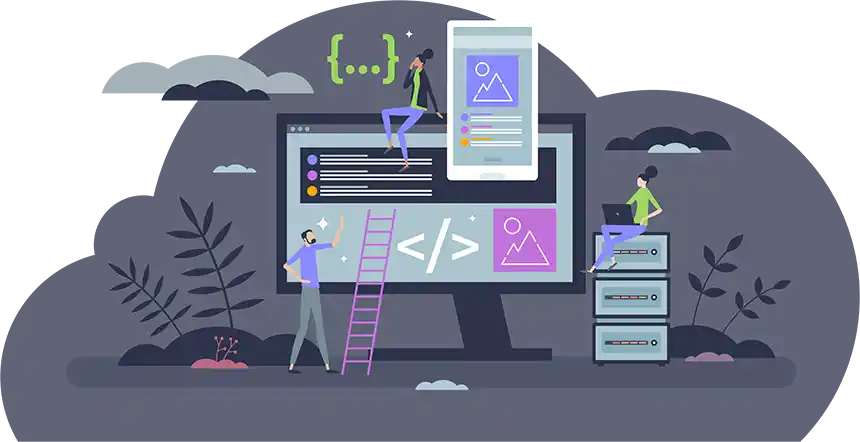Micro Frontends for Java Headless CMS Developers

Amanda Lee

The demand for scalable, flexible, and easily maintainable content applications has never been higher than it is today among leading enterprises. Customers want their digital experiences to be available on multiple channels, and developers want the work of building those applications to be as headache-free as possible.
Those needs have seen companies turn to headless CMSs and microservices to help them, and many companies, as well as the developers operating within them, often prefer the Java language and Java-based CMSs due to the robustness and flexibility they can provide. Yet, because everything seems fine on the backend, it doesn’t mean the frontend is also perfectly tuned. Luckily, a solution can be found by bringing the microservices approach to the frontend and embracing micro frontends.
In this article, we’ll highlight how combining micro frontends with a headless CMS can be the solution that Java developers need to build modern UIs.
The Good and Bad of Microservices
Microservices is a modern architectural approach where applications are structured as a collection of small, loosely coupled services. Each microservice is focused on a specific function or domain.
For example, instead of a bulky monolithic suite that handles content management, personalization, eCommerce, analytics, and ten other martech functions, each function can be broken down into a separate service. This modular architecture makes development easier and enables developers to scale and maintain complex applications.
Benefits
The key benefit of microservices is scalability. Since each application can scale independently, developers can quickly respond to changing system requirements or user demands. Businesses can allocate resources better, and updates to one area of the system don’t need to negatively impact the entire system or application as each service is self-contained. This way, updates and enhancements can be made without disrupting the system as a whole and allowing developers to embrace agile development approaches.
Drawbacks
While microservices have many benefits, the architecture can add complexity as developers need to connect different services, manage the communication between them, and ensure data consistency.
On the frontend, in particular, microservices can result in disjointed user interfaces since each service may have its own UI components and styles. This can lead to an inconsistent user experience, and as developers attempt to integrate multiple components, they inadvertently create a monolithic structure on the frontend.
Such a tightly-coupled frontend application shares the same issues as a traditional monolithic backend which also affects maintenance and scalability, ultimately negating some of the benefits the microservices architecture aimed to provide.
How Micro Frontends Solve UI Issues
Within the Java ecosystem, microservices have continued to grow in popularity as developers can use Spring Boot to build and deploy applications easily. Java developers can turn to micro frontends to help them solve the UI issues that can crop up while building microservices-based technology stacks. Micro frontends break the user interface into small, modular, and independent components on the frontend, just as microservices do on the backend.
Micro frontends (aka micro-frontends or microfrontends as they are called in different circles) support independent development and deployment, provide a consistent user experience, improve separation of concerns, and performance, and give developers more flexibility in their technology choices. For example, it doesn’t matter whether developers want to use React, Angular, Vue, or HTML templates (e.g., using Freemarker) for building their frontend technologies; a micro frontend approach is feasible. Java developers can also use JHipster to execute micro frontends easily.
Why Java Headless CMS Developers Should Care About the Frontend
While Java CMS developers might not always find themselves working on the frontend, Java headless CMS developers, in particular, should still be aware of what they can accomplish by using microfrontends. Some of the reasons include:
Collaboration and Communication: Backend and frontend developers need constant communication while working in the CMS. Understanding the principles of microfrontends can improve communication between these groups of developers and make it easier to collaborate on specific projects.
Architectural Decision Making: The frontend infrastructure is a crucial aspect of a headless CMS. As a result, micro frontend familiarity enables Java developers to make better decisions when building APIs or integrating microservices, as they will know how it might impact what the frontend developers are working on. This also matters for full-stack developers working on both the backend and frontend.
Micro frontends help remove some of the challenges that impact microservices-based technology stacks. For Java developers, understanding how they work and when to use them provides a holistic perspective of the entire system.
Headless CMS and Micro Frontends: A Perfect Match
Organizations that want to leverage the architectural benefits of microservices on the backend and also maintain those advantages on the frontend with micro frontends need the right systems in place. A headless CMS can provide the answer.
On the backend, headless architecture connects the frontend and the backend using APIs. These APIs also facilitate easier integrations with additional tools, including eCommerce platforms, analytics solutions, and more, thus facilitating the microservices approach.
On the frontend, a headless CMS gives developers the freedom they need to build content applications. They can use any frameworks and technologies they see fit to take full advantage of the micro frontend approach.
However, while a headless CMS can be a Java developer’s dream, enterprises need to select the right headless CMS to ensure that content authors also have all of the features they need. Otherwise, they risk bogging down developers with additional tasks and support tickets that distract them from other crucial work.
CrafterCMS: The Headless CMS For Micro Frontends (And More)
CrafterCMS is an open-source, API-first headless CMS for enterprises. As a Java-based platform, CrafterCMS provides everything developers need to build content-driven applications. They are free to use any framework on the frontend, as well as Groovy/Spring/Java, Node.js, Next.js, Freemarker and more on the backend. With CrafterCMS, software development and QA productivity has been proven to increase by over 40%.
While developers have the tools and frameworks they need, marketers and content authors are also provided with the capabilities to create and launch digital experiences. This includes user-friendly tools to create, update, and publish content to any digital channel, drag/drop experience building, WYSIWYG content editing, and multi-channel preview.
Learn more about how CrafterCMS gives developers and content authors all the tools and flexibility they need by signing up for a free cloud trial today.
Related Posts

How Should You Structure a Blog Post So AI Models Actually Cite It?

Amanda Jones

Publishing Content from Crafter Studio to External Systems and Databases

Sara Williams

Websites Are Dead?

Mike Vertal

No-Code Experience Building for Marketers & Designers

Amanda Lee










